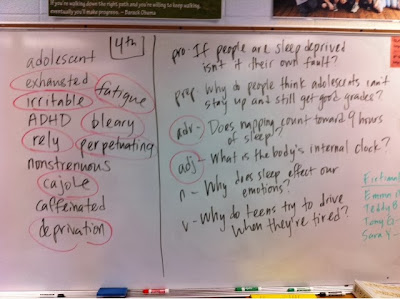On Saturday mornings I enjoy reading on the web, and I came across an interesting article that made me think and write.
The author: Deborah Blagg
It wasn't so much the article that got me thinking and writing, but the sidebar: "What U Should Know"
The sidebar summarizes the article, below what I imagine is a picture of either the author of the article or the book referenced in the article. That doesn't matter. What matters is the use of "U" instead of "You." This is the type of contextual usage that probably derives from the fact that the article appears on a university website and the substructure of articles appears in what is named Usable Knowledge.
Grammatically, it's incorrect usage. Contextually, there certainly had to have been intent behind it. (The article is dated October 30, 2009). And the article isn't even written for middle school or high school students, but for educators reading "current education research." Considering the audience, some might look down their nose at this incorrect usage. But this is the type of contextual usage, with intent and for effect, that we should be showing to, talking about, and teaching how-to with our students.
But as long as our assessments of students is rooted in a completely black-and-white, right-and-wrong system requiring the correct selection from multiple choice lists, our students will always come across something like this and think that it is "wrong." Our students will never have an understanding of writing within a context or with intent or for effect (purpose, audience, occasion--all that good stuff). This lack of experience will place our students at a disadvantage, especially those who go into a field utilizing writing for design.
This idea of black-and-white or right-and-wrong also makes me think of the idea of a "canon" regarding reading lists. The canon presupposes a list of "the right books," and everything else is on the wrong list. If we don't expand the students' experiences beyond dead white writers, or historical fiction and informational pieces (per the CCSS), then they'll never know how to respond when they are given the opportunity to read what they want. Truthfully, my biggest worry is that students who are stuck to the canon won't know how to chose their own books; they won't have the experiences to know what type of texts they actually enjoy reading and experiencing. That, in the long run, in my humble opinion, is more terrifying than the fact that our students may not have read Jane Austen or Charles Dickens. But I digress.
I guess, if I were to make a "What U Should Know" sidebar for my own thoughts this morning, then it would include expanding opportunities for students, in both writing and reading. The more students see that they can write within a certain context (well beyond the formal school essay), with intent and for effect (to achieve a specific purpose in the reader/audience), the more they will realize that, although grammatical usage rules do exist, and for very good reasons, there are certainly opportunities and occasions that allow for the breaking of those grammatical usage rules. This "seeing" must be a complete experience--to see, to analyze, to discuss, all in order to understand and then to attempt. The more students read choice, diverse texts, the more they will be able to gather their own data on themselves regarding the type of reader they are. As students gain an understanding of themselves as readers, and they progress in skill as readers, the more opportunities they will have to work their way toward some of the classics that make up the lists of "canons."
Just some thoughts. Let me know what you think.


















